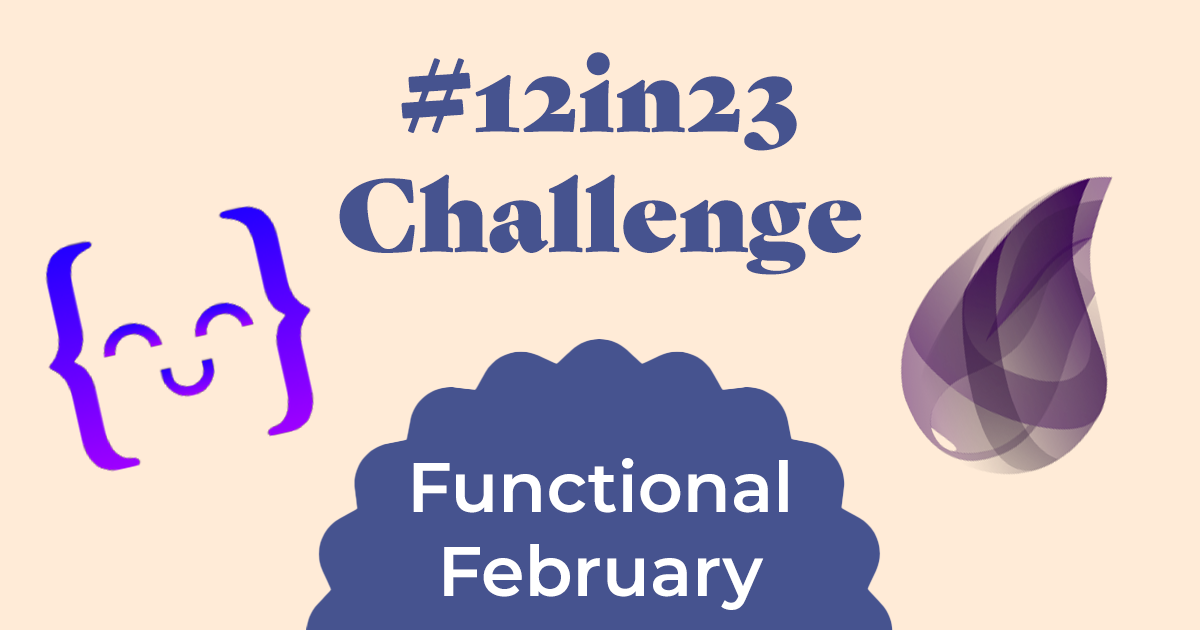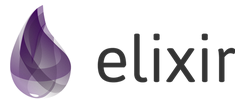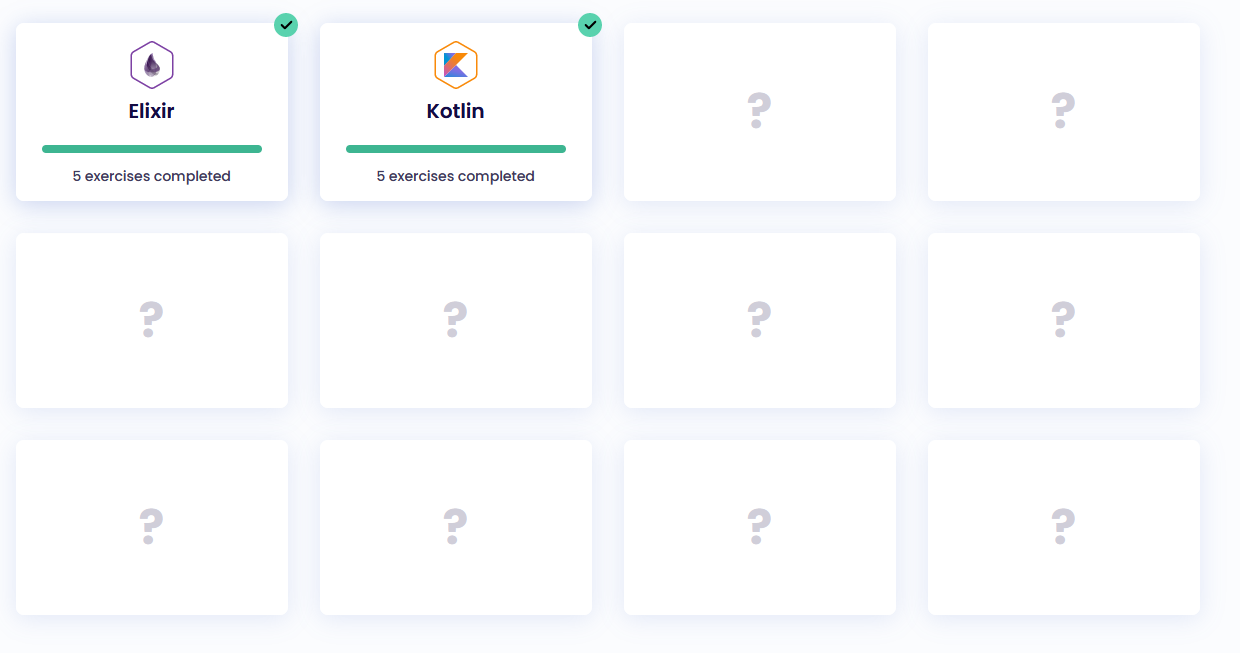Functional February: Exploring Elixir for Exercism's #12in23 Challenge
 Travis Horn
Travis Horn
For the month of February 2023, I continued Exercism's #12in23 Challenge by trying out the Elixir programming language.
If you're not familiar with this challenge, it's a programming-language learning challenge that tasks you with trying out 12 different languages in the year of 2023.
The idea is simple: each month, you'll focus on learning a new programming language. We'll provide resources and support to help you along the way, and you can track your progress and connect with other participants on our online community.
Each month has a specific theme in mind. For February, the theme is Functional February. You can work toward the goal by completing exercises from Clojure, Elixir, Erlang, F#, Gleam, Haskell, OCaml, Scala, or SML.
I chose Elixir!

Elixir is a dynamic, functional language for building scalable and maintainable applications.
Elixir runs on the Erlang VM, known for creating low-latency, distributed, and fault-tolerant systems. These capabilities and Elixir tooling allow developers to be productive in several domains, such as web development, embedded software, data pipelines, and multimedia processing, across a wide range of industries.
The nice part about choosing this functional language is that Exercism itself has a nice syllabus that you can follow to learn the language (they also have syllabuses for Clojure and F#). This way, I don't have to learn the language separately and then test myself on Exercism; I can do it all right from their site.
Note: In my last blog post, I mentioned that I will not be posting solutions to the exercises as I figured it goes against the spirit of the site. However, Exercism has promoted walkthroughs and live streams of the community solving the exercises. So, going forward, I will be posting my solutions here. If you want to avoid these "spoilers," I recommend trying the challenge yourself and then coming back here afterward.
When I did January's challenge with Kotlin, I had to set up my development environment locally. However, with some languages, including Elixir, you can code and test your solutions directly on Exercism!
I did it that way this time, but honestly, I might go ahead and set up a local development environment for each language going forward. I feel that it can give you a better idea of how each language works and what the developer experience is like. Plus, you can build your own applications if you have an idea and you like the language.
Hello, World!
Starting at the beginning with a classic "Hello, World!" exercise. The in-browser editor gave me the following starting code:
defmodule HelloWorld do
@doc """
Simply returns "Hello, World!"
"""
@spec hello :: String.t()
def hello do
"Goodbye, Mars!"
end
end
Without even knowing any Elixir, I was able to solve this one simply by changing the string "Goodbye, Mars!" to "Hello, World!".
But looking at the code closer can teach us a lot about how modules are defined, how documentation is a first-class citizen in Elixir, declaring typed function signatures/specifications, and more.
Lasagna
Unfortunately for lazy programmers, the "Hello, World!" exercise doesn't count toward the required 5 exercises to complete the monthly challenge. So the first qualifying exercise I did was called "Lasagna."
We are given 5 tasks:
Define the
Lasagna.expected_minutes_in_oven/0function that does not take any arguments and returns how many minutes the lasagna should be in the oven. According to the cooking book, the expected oven time in minutes is 40Define the
Lasagna.remaining_minutes_in_oven/1function that takes the actual minutes the lasagna has been in the oven as an argument and returns how many minutes the lasagna still has to remain in the oven, based on the expected oven time in minutes from the previous taskDefine the
Lasagna.preparation_time_in_minutes/1function that takes the number of layers you added to the lasagna as an argument and returns how many minutes you spent preparing the lasagna, assuming each layer takes you 2 minutes to prepareDefine the
Lasagna.total_time_in_minutes/2function that takes two arguments: the first argument is the number of layers you added to the lasagna, and the second argument is the number of minutes the lasagna has been in the oven. The function should return how many minutes in total you've worked on cooking the lasagna, which is the sum of the preparation time in minutes, and the time in minutes the lasagna has spent in the oven at the momentDefine the
Lasagna.alarm/0function that does not take any arguments and returns a message indicating that the lasagna is ready to eat
The Lasagna.expected_minutes_in_oven/0 means that Lasagna is the module name, expected_minutes_in_oven is the function name, and 0 is the number of arguments the function accepts.
Since I had been following along with Exercism's Elixir syllabus (highly recommended), I already knew how to do function shorthand and basic math. My solution was simple.
defmodule Lasagna do
def expected_minutes_in_oven, do: 40
def remaining_minutes_in_oven(minutes_elapsed), do: expected_minutes_in_oven() - minutes_elapsed
def preparation_time_in_minutes(layers), do: layers * 2
def total_time_in_minutes(layers, minutes_elapsed), do: preparation_time_in_minutes(layers) + minutes_elapsed
def alarm(), do: "Ding!"
end
Lasagna.expected_minutes_in_oven/0 always returns the integer 40 .
Lasagna.remaining_minutes_in_oven/1 takes the result from that first function and subtracts the number of minutes elapsed that was passed in as an argument.
Lasagna.preparation_time_in_minutes/1 simply multiplies the passed-in number of layers by 2.
Lasagna.total_time_in_minutes/2 uses that previous function to multiply the passed-in number of layers and then adds the passed-in number of minutes elapsed.
Finally, Lasagna.alarm/0 always returns the string "Ding!"
Pacman Rules
This exercise was all about using conditional logic. There are 4 tasks:
Define the
Rules.eat_ghost?/2function that takes two arguments (if Pac-Man has a power pellet active and if Pac-Man is touching a ghost) and returns a boolean value if Pac-Man is able to eat the ghost. The function should return true only if Pac-Man has a power pellet active and is touching a ghost.Define the
Rules.score?/2function that takes two arguments (if Pac-Man is touching a power pellet and if Pac-Man is touching a dot) and returns a boolean value if Pac-Man scored. The function should return true if Pac-Man is touching a power pellet or a dot.Define the
Rules.lose?/2function that takes two arguments (if Pac-Man has a power pellet active and if Pac-Man is touching a ghost) and returns a boolean value if Pac-Man loses. The function should return true if Pac-Man is touching a ghost and does not have a power pellet active.Define the
Rules.win?/3function that takes three arguments (if Pac-Man has eaten all of the dots, if Pac-Man has a power pellet active, and if Pac-Man is touching a ghost) and returns a boolean value if Pac-Man wins. The function should return true if Pac-Man has eaten all of the dots and has not lost based on the arguments defined in part 3.
Again, since I was following the syllabus, I understood how the logic operators and, or, and not work. Once I understood how the Pacman rules were supposed to work, the solution was clear
defmodule Rules do
def eat_ghost?(power_pellet_active, touching_ghost) do
power_pellet_active and touching_ghost
end
def score?(touching_power_pellet, touching_dot) do
touching_power_pellet or touching_dot
end
def lose?(power_pellet_active, touching_ghost) do
not power_pellet_active and touching_ghost
end
def win?(has_eaten_all_dots, power_pellet_active, touching_ghost) do
has_eaten_all_dots and not lose?(power_pellet_active, touching_ghost)
end
end
Rules.eat_ghost?/2 returns true only if there is a power pellet active and Pacman is touching a ghost.
Rules.score?/2 returns true if either Pacman is touching a power pellet or he is touching a dot.
Rules.lose?/2 returns true if there is not a power pellet active and Pacman is touch a ghost.
Rules.win?/3 returns true if Pacman has eaten all the dots and the previous lose? condition is false.
Freelancer Rates
This one was all about integers and floating point numbers (floats). We have 4 tasks:
Implement a function to calculate the daily rate given an hourly rate
Implement a function to calculate the price after a discount
Implement a function to calculate the monthly rate, and apply a discount
Implement a function that takes a budget, an hourly rate, and a discount, and calculates how many days of work that covers
There are more business logic rules and expected return types in the actual exercise, but I don't think its particularly relevant to repeat here. You can look at the full exercises yourself if you want to start Exercism's Elixir track.
def daily_rate(hourly_rate) do
hourly_rate * 8.0
end
This was the easiest one. Just multiply the hourly rate by 8. Since they wanted the result as a float, I used 8.0 instead of 8.
def apply_discount(before_discount, discount) do
before_discount * (1 - discount / 100)
end
The discount is given as a fractional number representing a percentage. For example 25.0 represents 25%. So in my solution, I take 1 - discount / 100 to get 0.75, which I then multiply by the before_discount rate to get the final return value.
def monthly_rate(hourly_rate, discount) do
ceil(apply_discount(daily_rate(hourly_rate) * 22, discount))
end
For this one, they were expecting the value to be rounded up. So I used my previously writeen daily_rate function to get the daily rate, multiplied that by 22 to get the monthly rate, applied the discount, and then rounded everything up with ceil.
def days_in_budget(budget, hourly_rate, discount) do
Float.floor(budget / apply_discount(hourly_rate * 8, discount), 1)
end
This was the most complicated function in the exercise, but it follows the same basic formula of composing functions together. Divide the supplied budget by the discounted hourly rate, then use Float.floor to return the expected result rounded down to one decimal place.
Secrets
This was a fun one that used anonymous functions and bit manipulation. There are 7 tasks this time:
Implement
Secrets.secret_add/1. It should return a function which takes one argument and adds to it the argument passed in tosecret_add.Implement
Secrets.secret_subtract/1. It should return a function which takes one argument and subtracts the secret passed in tosecret_subtractfrom that argument.Implement
Secrets.secret_multiply/1. It should return a function which takes one argument and multiplies it by the secret passed in tosecret_multiply.Implement
Secrets.secret_divide/1. It should return a function which takes one argument and divides it by the secret passed in tosecret_divide.Implement
Secrets.secret_and/1. It should return a function which takes one argument and performs a bitwise and operation on it and the secret passed in tosecret_and.Implement
Secrets.secret_xor/1. It should return a function which takes one argument and performs a bitwise xor operation on it and the secret passed in tosecret_xor.Implement
Secrets.secret_combine/2. It should return a function which takes one argument and applies to it the two functions passed in tosecret_combinein order.
Building anonymous functions and use closures are some powerful concepts that some people find very hard to wrap their head around at first. But if you can understand them, you'll find how useful they can be for almost any programming task.
First, I'll talk about my solution to the first 6 tasks:
def secret_add(secret), do: &(&1 + secret)
def secret_subtract(secret), do: &(&1 - secret)
def secret_multiply(secret), do: &(&1 * secret)
def secret_divide(secret), do: &(div(&1, secret))
def secret_and(secret), do: &(Bitwise.band(&1, secret))
def secret_xor(secret), do: &(Bitwise.bxor(&1, secret))
Remember that each of our functions should be returning functions themselves. This is the tricky part.
In the syllabus, I learned the shorthand capture notation, which I use here. &( ... ) represents an anonymous function. Anything inside the parentheses is what that inner function will do/return.
For example, the first function - Secrets.secret_add/1 - accepts a number (represented by secret. We then return a function that also accepts a number (represented by &1) and adds secret to it.
If you can understand that, you can then understand the remaining functions in the solution. They all just return anonymous functions that do some math. The last two above do "bitwise math" which you might have to read up on if you're not familiar. But honestly, you don't have to understand it to see that we're just applying an operator on &1 and secret just like the rest of the functions.
The final function in this exercise was much more difficult for me to code but very easy to understand looking back at it. This function must accept two of the previous functions and "combine" them. Here's the solution:
def secret_combine(secret_function1, secret_function2) do
&(secret_function2.(secret_function1.(&1)))
end
Looking as deep into the composition as we can, you can see that we first pass &1 to the first passed-in function, then that result gets passed into the second function, then finally the whole thing gets returned as a function itself. As I said, it's a little tricky at first, but I highly recommend learning this pattern if you want to better yourself as a programmer.
Language List
The last exercise I did to complete this month's challenge was "Language List." The big concept to understand here is how Elixir handles Lists. If you know anything about Linked Lists, this will come natural to you.
There are 6 tasks:
Define the
new/0function that takes no arguments and returns an empty list.Define the
add/2function that takes 2 arguments (a language list and a string literal of a language). It should return the resulting list with the new language prepended to the given list.Define the
remove/1function that takes 1 argument (a language list). It should return the list without the first item.Define the
first/1function that takes 1 argument (a language list). It should return the first language in the list.Define the
count/1function that takes 1 argument (a language list). It should return the number of languages in the list.Define the
functional_list?/1function which takes 1 argument (a language list). It should return a boolean value. It should return true if "Elixir" is one of the languages in the list.
Here we go.
def new(), do: []
This couldn't get must simpler. We just return an empty list [].
def add(list, language), do: [language | list]
Using [head | tail] notation makes it easy to prepend a passed-in language to a passed-in list.
def remove(list) do
[_head | tail] = list
tail
end
For this one, I am simply assigning the first element in the list to _head and the remaining elements to tail. Then I return tail which effectively removes the first element.
def first(list) do
[head | _tail] = list
head
end
Notice this one is almost identical to the previous one. We're just returning the head (first element) this time.
Looking back, I'm sure there is a way to do both remove and first in a single line. If I continue my Elixir journey, I'm sure that would be easy information to find.
def count(list), do: length(list)
Easy. Use length to return the length of a list.
def functional_list?(list), do: "Elixir" in list
In the syllabus, I learned about the in operator which made this one easy, too.
Two months down
With those five exercises in Elixir complete, I'm finished with Functional February! Ten more months and ten more languages to go.

Elixir was a great experience. I enjoy functional programming. I tend to write my apps functionally if at all possible. I use this paradigm for both work and fun projects. Elixir was a joy to use, but I feel like I was missing something. Since I only used the in-browser code editor on Exercism's site, I don't feel like I got the full experience. If I decide to continue trying Elixir, I will definitely set up a local development environment on my PC. In fact, I will probably attempt to develop locally for all future languages as I progress through the #12in23 challenge.
Subscribe to my newsletter
Read articles from Travis Horn directly inside your inbox. Subscribe to the newsletter, and don't miss out.
Written by

Travis Horn
Travis Horn
I have a passion for discovering and working with cutting-edge technology. I am a constant and quick learner. I enjoy collaborating with others to solve problems. I believe helping people achieve their goals helps me achieve mine.